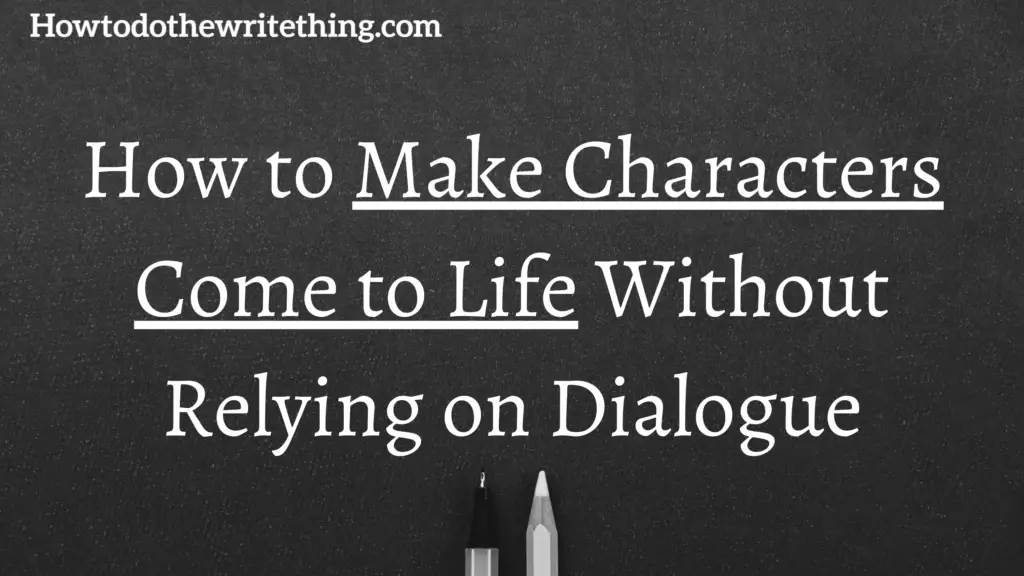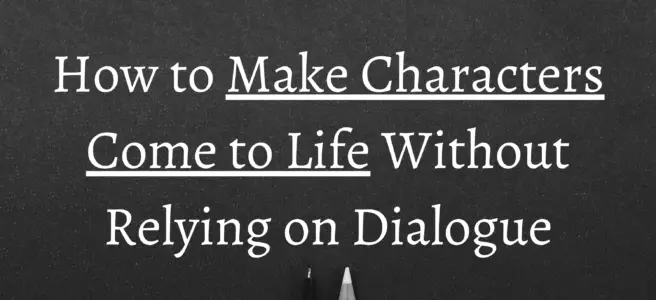
How to Make Characters Come to Life Without Relying on Dialogue
How do some authors like Gabriel Garcia Marquez make characters jump off the page with very little dialogue? There’s a rumor that in one of Marquez’s books, “One Hundred Years of Solitude,” that only 5% of the book is dialogue.
For an average that is a ridiculously small amount of dialogue, but readers who pick it up seem to love it.
And they say things like, “every character feels like they could reach out of the pages and touch me…”
Most of us rely on dialogue to define our characters and help our reader get to know them. After all, communication is a normal day to day way to get to know someone.
So how does an author do that? How can we do that?
How can we make our characters so life-like, that our readers will feel like they could reach out and touch them?
Let’s dive in.
Actions speak louder than words.
Ouch! It stings! It burns us precious! But it’s so true!
It’s true in life and it’s true in storytelling. I could tell you all day how strong my character is but until I tell you that she can bench 1000 lbs (it’s supposed to be an absurd amount) your not gonna be wowed.
And really though just telling someone that my character can bench that much doesn’t… actually I changed my mind.
Picture this,
“Stacy marches through the halls. She stamps down the stairwell at Dudemer High. She’s determined. No one can stop her. She’s tired of what everyone says about her. She’s not going to hide her powers any longer.
She kicks open the doors to the gym. The gym is filled with students who all turned their heads at the echoing noise.
She doesn’t back down from all the attention she’s just received. She sees the bench press. Kids are looking at each other at her and murmuring. Stacy grabs two 50s and throws them on the bar as if they’re nothing.
Now faces are starting to turn into frowns. It looks unreal the way she grabs two more 50s and throws them on until she has five 50s on each side. She wanted more but the bar couldn’t fit it and for some reason, the cheap school didn’t have 100s.
Stacy got under the bar without a second to lose and threw it up countless times. It was so light to her. By this time the gym was in chaos. Kids were shouting laughing, screaming. Phones were out and streaming. It was out there. Just a fraction of Stacy’s real strength was going viral.
To finish it off she smirked. Grabbed the bar of the bench and threw it 20 or so feet into the bleachers which broke under the weight. Eyes were wide and now they all couldn’t explain it away.
Stacy took a couple of breaths and walked out to head to Geometry, which she was late for.”
Okay, so it’s not pretty and it needs a ton of editing (don’t be afraid to just write something quickly that you can always edit later; get your ideas out of your head and onto a page), but this scene shows a lot of what’s going on with Stacy with zero dialogue.
We can see that she’s angry. We know she’s fed up with people. She has superhuman abilities and she’s extremely sick of hiding them. She just wants to be herself and so she does something about it and shows the world by stomping into a crowded gym and showing everyone her true strength.
This scene could in theory have a little dialogue, but it’s not altogether necessary. Maybe we can show the reader more of what’s going on in our character’s life by saying less in dialogue and giving them more action to follow.
Interested in starting a blog of your own? Check out Bluehost.
Dialogue can make a scene drag on.
Sometimes the dialogue is just too much. If it could be cut out go ahead and cut it out. Dialogue should have a purpose and a point.
It should not be overdone. It needs to get the point across and be done.
Too much dialogue can lead to lulls in the story instead of moving the plot forward.
If dialogue doesn’t move the plot forward is it really necessary in the first place for that specific scene?
This isn’t going to work for all readers as some really look forward to the character dialogue and everything it reveals about a character.
But don’t get heavy in dialogue that doesn’t get us to the next plot point.
Vivid descriptions leave a lasting impression.
Vivid and unexpected descriptions, even if short leave a lasting impression on the reader.
Imagine this,
“Stacey stabbed his eye and it burst on her white blouse. He screamed turned around and seared his hand on the stove letting out another scream.”
Or
“The gun went off and the Doctor felt like something pressed against him. It didn’t hurt but he looked down and saw blood starting to spill out his shirt. He went into his back office and grabbed string, iodine, and an iron bar. He set the iron bar in the fire.
He dipped the string in the iodine and then proceeded to push it through the bloody hole all the way through and out his back.”
These descriptions are vivid and shocking, so it helps leave an impression.
If your story can’t naturally bring about shocking things like these it’s okay, just try to be vivid and creative with the tools at your disposal.
We can project what the characters ought to be feeling.
We don’t have to use dialogue to tell what a certain character is truly feeling.
Picture this,
“Stacy slammed the front door.
Her mother nearly fell out of her chair in front of the TV. “Stacy! Is that you! What’re you slamming the door for?!”
Stacy didn’t reply. She just rolled her eyes, grabbed a bottle out of the fridge, and stomped up the stairs where she slammed her bedroom door too.
“Stacy! You better knock it off! You’re gonna give me a heart attack and then you’re really gonna be sor-“
Before she could hear the last words of her mother’s rant she had already hit the power button on the remote to her stereo.”
Stacy is obviously still so filled with rage and her mother could be justified in her words, but maybe we are starting to see that her relationship with her mother is not the best.
This could be on Stacy’s end, her mother’s, or both.
But we can see that both of our characters are feeling negative emotions and we didn’t have to have one character tell another character how they were feeling about any certain situation.
Interested in starting a blog of your own? Check out Bluehost.
Final Thoughts
When we are able to use action to tell our reader what our character is feeling and going through, it’ll be much harder for the reader to lose interest compared to overloading them with dialogue to try explaining what our character is feeling.
Actions speak volumes. We may have to edit more to make sure it comes across correctly, but that’s okay. Editing is a crucial part of the process.
Practice describing scenes without dialogue, only using vivid description and imagery to express what your characters are thinking and feeling.
Get to a place where it comes across so naturally that it’s second nature to be able to use the skill of writing a scene without dialogue that makes your character jump off the page.
How to Make Characters Come to Life Without Relying on Dialogue
Enjoying How to Make Characters Come to Life Without Relying on Dialogue? Take a moment and consider sharing this social-friendly image to say thanks and feel free to comment with your thoughts below! 🙂

Interested in starting a blog of your own? Check out Bluehost.
Hope this helps!
Happy writing!
Resources:
How to Start a Blog in 11 Simple Easy Steps in 2020
How to Write a Book: 32 Tips | Your MASSIVE Guide How to Write a Book
This post:
How to Make Characters Come to Life Without Relying on Dialogue




